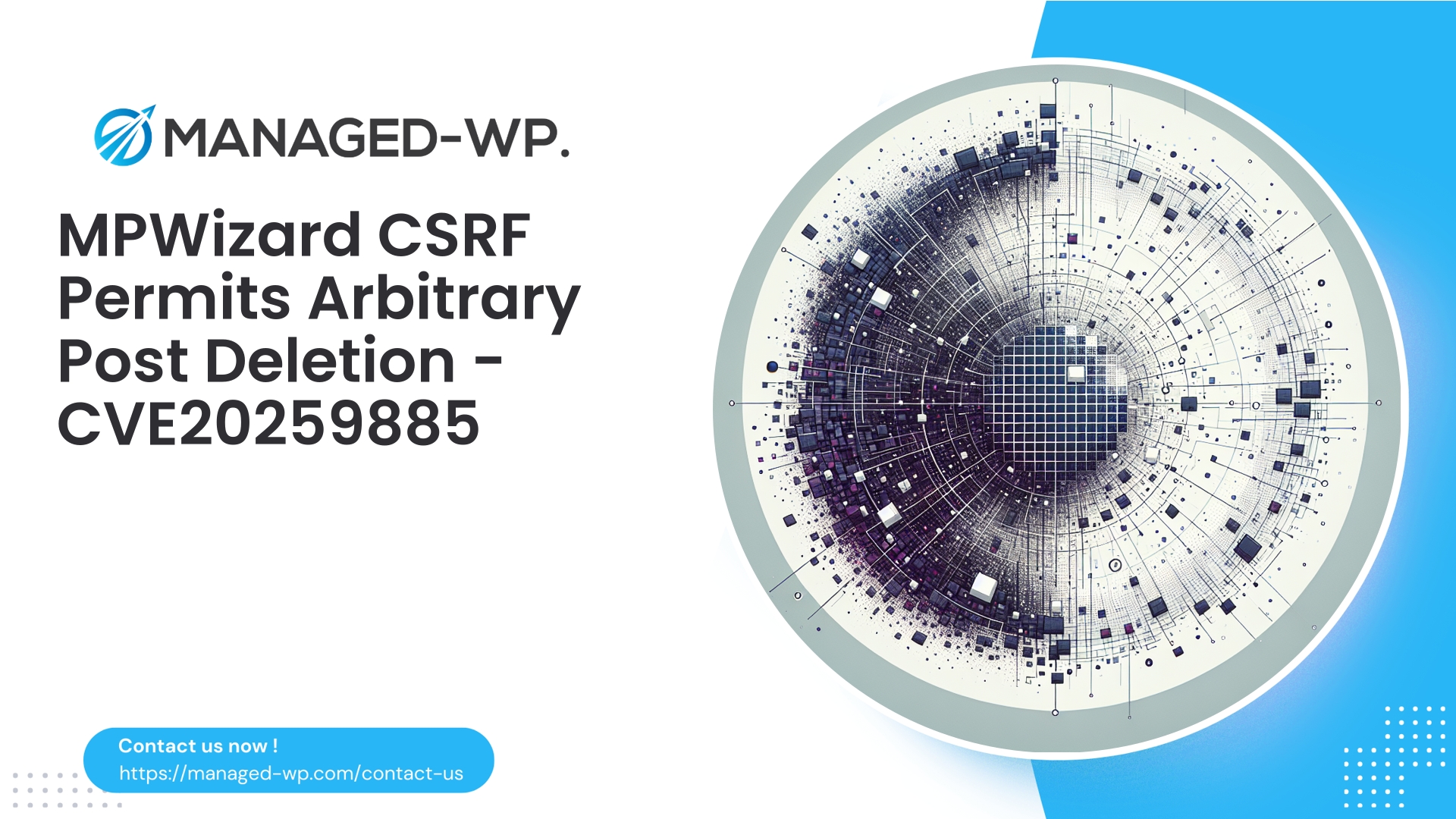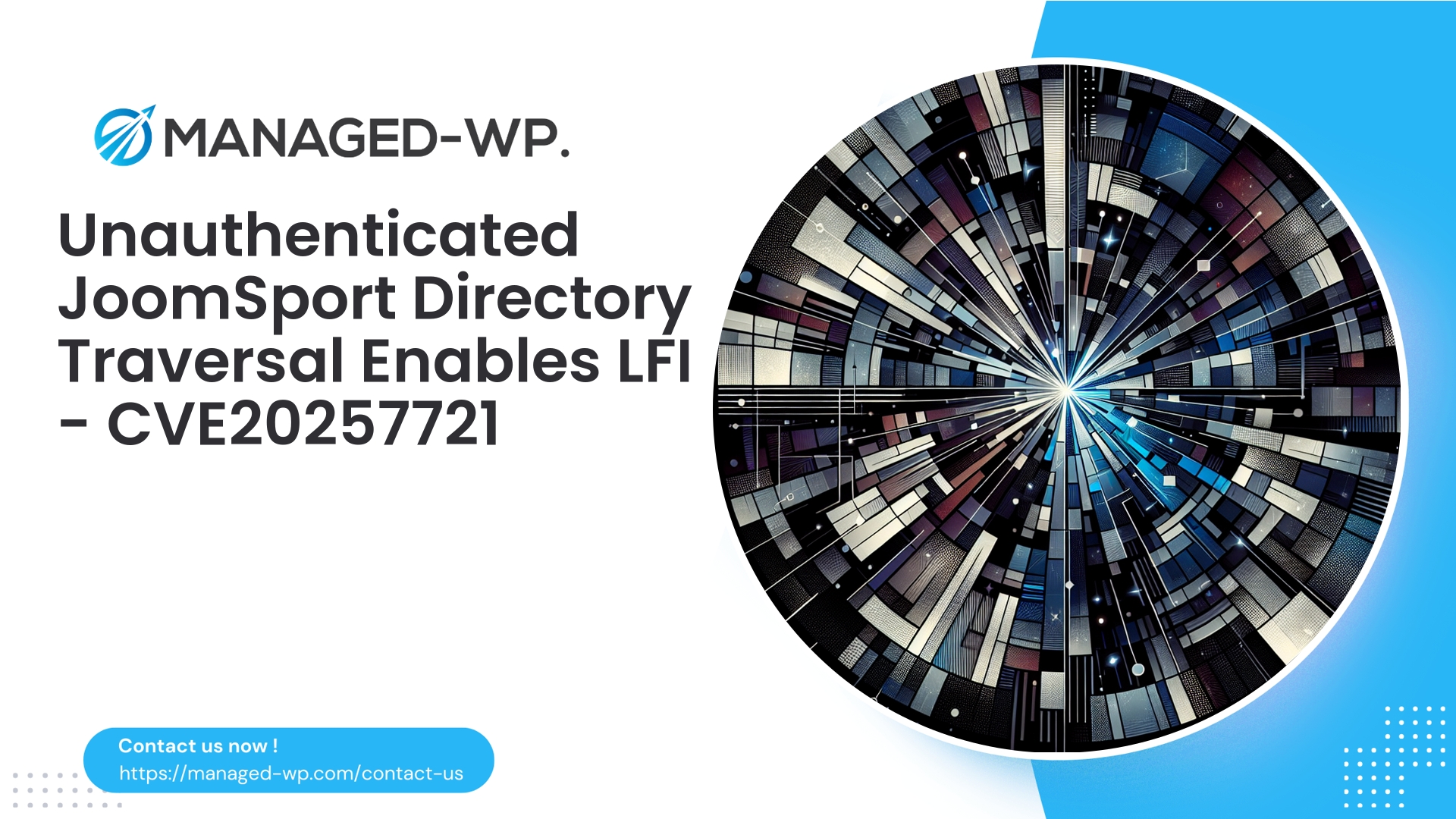| 插件名称 | MPWizard |
|---|---|
| 漏洞类型 | CSRF |
| CVE编号 | CVE-2025-9885 |
| 紧急 | 低的 |
| CVE 发布日期 | 2025-10-03 |
| 源网址 | CVE-2025-9885 |
MPWizard <= 1.2.1 — CSRF 漏洞允许任意删除帖子 (CVE-2025-9885):网站所有者应立即采取的措施
作者: 托管式 WordPress 安全专家
执行摘要
MPWizard 插件中发现了一个跨站请求伪造 (CSRF) 漏洞,影响 1.2.1 及更低版本,漏洞编号为 CVE-2025-9885。该漏洞使攻击者能够诱骗具有特权的 WordPress 用户(例如管理员或编辑)在已验证身份的情况下无意中删除文章,原因是插件中对 nonce、权限和引用数据的验证不足。
虽然公开的 CVSS 评分为中等 (4.3),但其实际影响很大程度上取决于您网站的结构、特权用户数量以及您是否采用了 Web 应用程序防火墙 (WAF) 等自动化防御机制。如果不加以解决,此漏洞可能导致内容被删除、工作流程中断以及声誉受损。
我们 Managed-WP 团队从美国 WordPress 安全专家的角度提供了这项分析,概述了风险因素、技术概述和即时缓解策略——重点介绍了在官方插件更新延迟或不可用时,托管虚拟补丁的价值。
谁应该读这篇文章?
- WordPress 管理员和网站所有者,运行 MPWizard 版本 1.2.1 或更早版本。
- 负责客户 WordPress 环境的托管服务提供商。
- 安全和事件响应团队监控 WordPress 基础设施。
- 开发人员、代理机构和顾问管理多个 WordPress 安装。
了解漏洞(通俗易懂版)
CSRF 攻击是指攻击者在用户不知情的情况下篡改已认证用户的浏览器,使其在已登录的网站上执行特定操作。在本例中,MPWizard 错误地暴露了一个敏感操作,允许在未强制执行标准 WordPress 安全控制(例如 nonce 验证或权限检查)的情况下删除文章。攻击者可以利用此漏洞,诱骗管理员访问恶意网站或点击精心构造的链接,从而使用管理员的凭据在目标网站上静默地删除文章。
关键细节:
- 受影响的插件版本:MPWizard ≤ 1.2.1
- 已分配的 CVE 编号:CVE-2025-9885
- 公众严重程度评级:低(CVSS 4.3),但潜在的实际影响因情况而异
- 利用此漏洞需要已认证的管理员或编辑人员在登录状态下被诱骗访问恶意网页。
为什么官方CVSS可能低估了您的风险
虽然 CVSS 评分很有用,但它并不总是能反映您网站的独特风险:
- “低”严重性并不等于低影响——如果关键帖子被删除,内容集中且管理员较少的目标可能会遭受灾难性损失。
- 高流量或多站点 WordPress 网络更容易因内容破坏而遭受运营和声誉损害。
- 一旦漏洞利用细节公开,攻击者通常会迅速实现 CSRF 漏洞利用的自动化,因此需要迅速采取缓解措施。
漏洞运作方式
从宏观层面来看:
- MPWizard 实现了一个端点(可能是管理员 AJAX 处理程序或表单提交),负责删除帖子。
- 此端点接受包含参数的 HTTP 请求,这些参数用于标识目标帖子和删除操作。
- 由于 nonce 验证缺失或存在缺陷、能力检查不当或来源验证不足,端点可能会被未经授权的跨域请求触发。
- 攻击者创建一个恶意页面,当已认证的管理员访问该页面时,其浏览器会在后台静默向存在漏洞的网站发送删除请求。这会导致帖子删除操作以合法管理员的身份进行。
重要的: Managed-WP 故意隐瞒详细的漏洞利用步骤,以降低被广泛滥用的风险。
可利用性和潜在敌方目标
易于利用:
- 比较容易理解,假设攻击者能够诱骗管理员用户访问精心制作的恶意内容。
- 网络钓鱼邮件、社交工程或恶意广告是实现这一目标的常见手段。
攻击者的可能动机包括:
- 有针对性地删除战略性帖子或页面,以干扰信息传播。
- 大量删除帖子,以造成运营混乱。
- 将此漏洞与其他漏洞结合起来,可实现持久访问或数据窃取。
- 破坏工作流程、引发声誉损害或造成经济损失。
立即采取的缓解措施
如果您运行的站点版本低于或等于 MPWizard 1.2.1,请按优先级执行以下操作:
-
确认 MPWizard 版本
- 请检查 WordPress 管理后台的“插件”部分,以确认已安装的 MPWizard 版本。
- 对于代理机构或主机商,对所有托管站点进行清点。
-
暂时禁用 MPWizard
- 如果可能,请在生产环境中停用该插件,直到实施补丁或有效的保护措施为止。
- 请注意,禁用该插件会停止依赖于该插件的功能,但会立即消除删除风险。
-
如果禁用不可行,则限制管理员访问权限
- 限制wp-admin访问权限,仅允许受信任的IP地址访问。
- 暂时中止或审查具有管理员/编辑角色的帐户,以减少风险。
-
部署 WAF 保护
- 应用 Web 应用程序防火墙 (WAF) 规则来阻止针对 MPWizard 删除端点的可疑 POST 或 GET 请求。
- 如果正在使用托管 WAF 服务,请请求立即代表您进行虚拟修补以降低风险。
-
确保备份安全并进行验证
- 创建网站(数据库+文件)的全新备份。
- 确保备份文件异地存储,并定期测试恢复程序。
-
提醒网站运营人员并强制执行密码更改
- 如果怀疑存在恶意利用行为,请通知所有相关人员,并强制所有高权限帐户重置密码。
检测和事件分类
审查以下内容以识别潜在的剥削行为:
- 分析 Web 服务器访问日志,查找来自外部引用者的异常 POST 请求,这些请求指向站点管理员或 MPWizard 插件端点,重点关注指示删除操作的参数(例如,action=delete)。
- 监控 WordPress 审核或活动日志,查找意外的帖子删除事件,并验证是哪些用户帐户执行了这些操作。
- 检查数据库,查看是否有帖子数量突然减少,或者是否有条目在短时间内被移至回收站。
- 检查插件目录,查看漏洞披露日期前后是否存在意外的文件修改。
调查示例命令:
wp post list --post_type=post --format=csv | wc -l
SELECT ID, post_title, post_status, post_modified FROM wp_posts WHERE post_modified >= DATE_SUB(NOW(), INTERVAL 24 HOUR);
grep -i "mpwizard" /var/log/nginx/access.log | tail -n 200
建议的补救措施
短期:
- 在可行的情况下,停用存在漏洞的 MPWizard 插件。对于业务关键型插件,在修复漏洞之前,将受影响的功能从生产环境中移除。
- 使用 WAF 虚拟补丁阻止尝试删除操作的请求,为官方更新争取时间。
长期:
- 只有在供应商提供的、安全的版本可用且经过全面测试后,才能重新启用 MPWizard。
- 如果供应商不提供修复程序,请用维护良好的替代方案替换 MPWizard 或禁用该功能。
- 遵循最小权限原则——将管理角色限制在受信任的人员,并对内容编辑实施细粒度的权限控制。
托管式 WAF 和虚拟补丁的作用
当厂商补丁迟迟未发布或根本没有发布时,托管式 Web 应用防火墙可以作为至关重要的临时解决方案。它们通过在攻击向量到达网站应用层之前将其拦截,提供快速、低影响的缓解措施,尤其适用于像 CSRF 漏洞这样的安全漏洞。
- 除非请求来自可信来源或附带有效的 WordPress nonce,否则阻止对敏感插件端点的请求。
- 识别并拒绝包含可疑删除参数的请求。
- 对自动化和可疑的流量模式进行速率限制或列入黑名单。
- 提供全面的日志和警报,以便安全团队了解攻击尝试。
WAF规则概念标准示例:
- 阻止未经身份验证的 POST 请求,其中:
- 请求路径与 MPWizard 删除相关的端点或操作匹配。
- Referer 标头不存在或不属于您的域。
- WP nonce 缺失或无效。
请注意,调整 WAF 规则对于避免干扰合法的管理操作至关重要。Managed-WP 的安全团队提供在生产环境中测试过的定制虚拟补丁,以确保安全性和有效性。
制定WAF规则的指导原则
避免:
- 过于宽泛的规则阻止了所有对 wp-admin 的 POST 请求,这可能会破坏管理员的用户体验。
- 仅依赖用户代理字符串或 IP 地址块而不进行上下文检查的规则。
- 严格的、精确匹配的有效载荷要求,攻击者只需稍作修改即可轻松绕过。
包括:
- 按特定端点(例如 admin-ajax.php 或 admin-post.php)筛选的请求,并结合插件特定的操作参数。
- 验证 referer 和 origin 标头是否与您的域名匹配,以进行管理员级别的操作。
- 对重复可疑访问尝试的IP地址进行临时灰名单列入。
WordPress 安全最佳实践清单
- 保持 WordPress 核心、主题和所有插件的更新;优先更新那些积极维护且信息披露政策透明的插件。
- 限制拥有管理员权限的用户数量;不要共享凭据。
- 对所有管理员和编辑帐户强制执行多因素身份验证 (MFA)。
- 实施活动/审计日志插件,以监控内容更改和用户行为。
- 维护自动化备份,并采用经过测试的恢复流程。
- 尽可能设计需要双重确认才能执行破坏性操作的工作流程。
- 部署安全标头和安全 cookie 设置(HttpOnly、Secure、SameSite)以降低 CSRF 风险。
- 在代码审核期间,检查所有插件是否正确使用了 WordPress 安全控制功能。
内容删除后的恢复步骤
如果检测到与此漏洞相关的帖子删除事件,请采取以下步骤:
- 立即获取网站快照以进行取证分析。
- 从已知的最新安全备份中恢复;如果存在增量备份,请考虑进行时间点恢复。
- 检查 WordPress 回收站状态;许多已删除的文章可能仍然可以恢复:
wp post list --post_status=trash --format=csv wp post restore - 使管理员会话和密码失效并重置:
wp 用户会话销毁 - 如果 API 密钥或凭据被盗用,应撤销并轮换与管理员帐户绑定的 API 密钥或凭据。
- 进行全面的恶意软件扫描,以检测任何持续存在的攻击者立足点。
- 恢复后,实施缓解措施,包括插件更新、WAF 规则和持续监控。
沟通与法律考量
- 对于处理受监管或敏感数据的网站,应及时与法律和合规团队联系,并保留详细的事件记录。
- 向利益相关者透明地通报所发生的事情、采取的行动以及正在进行的预防措施。
- 保存日志和证据数据,以备可能的调查或审计。
日志记录和监控的检测规则
针对可疑迹象建立警报,例如:
- 短时间内出现大量帖子删除。
- WP-Admin 请求包含异常或外部引用。
- 包含 MPWizard 操作参数的意外 POST 请求。
- 未经授权的新插件安装或文件更改。
常见问题解答 (FAQ)
问:CVSS评分偏低,我应该感到担忧吗?
答:无需惊慌,但需迅速采取行动。CVSS评分低并不总是意味着实际影响小,尤其对于拥有高价值内容或多个特权用户的网站而言更是如此。务必优先采取遏制和保护措施。
问:我可以完全依靠 WordPress nonce 来进行保护吗?
答:正确实施时有效,但此漏洞存在是因为 MPWizard 忽略了正确的 nonce 验证。如果插件误用或省略 nonce,仅仅依赖 nonce 是不够的。
问:移除插件有多紧急?
答:如果停用不会影响您的业务,建议立即停用。如果无法移除,请采取 WAF 缓解措施并限制管理员访问权限,直到应用安全的插件版本。
概念性WAF缓解策略
笔记: 这些是给安全团队的指导原则;避免公开部署原始漏洞利用模式。
- 确定通过 admin-ajax.php 或 admin-post.php 进行删除时使用的插件端点和管理操作名称。
- 创建以下规则:
- 向这些端点发送 POST 请求。
- 检查“action”参数是否与已知的删除操作匹配。
- 排除受信任的管理员 IP 地址范围。
- 验证 Origin 和 Referer 标头是否属于您的域名。
- 阻止并记录可疑请求。
- 首先在监控模式下运行,以调整规则并防止误报,然后再强制执行阻止模式。
托管虚拟补丁的重要性
当供应商延迟或跳过安全更新时,通过托管式Web应用防火墙(WAF)进行虚拟修补至关重要。它:
- 提供即时、可扩展的保护,且无停机时间。
- 无需对您的 WordPress 代码库进行任何更改。
- 对于不再积极维护的插件来说,这一点尤其重要。
在 Managed-WP,我们制定精确、影响最小的规则,优先考虑运营连续性,同时有效缓解威胁。
时间线及披露
- 2025 年 10 月 3 日:MPWizard ≤ 1.2.1 的 CVE-2025-9885 漏洞披露。
- 已负责任地向插件供应商报告安全研究结果;如果官方修复程序延迟,建议进行虚拟修补。
总结性建议
- 如果您使用的是 MPWizard ≤ 1.2.1 版本,请将此视为紧急问题——立即清点您的站点。
- 短期措施:停用或限制使用,立即进行备份,部署托管 WAF 或虚拟补丁。
- 中期计划:在安全版本发布后更新或替换插件。
- 长期措施:实施严格的管理员访问控制、多因素身份验证、定期备份和托管防火墙保护。
使用 Managed-WP 保护您的 WordPress 网站 — 免费托管安全服务
立即开始使用 Managed-WP 免费计划 — 为每个 WordPress 网站提供基本安全保障
如果您担心此类漏洞,并希望获得快速可靠的保护,请考虑使用 Managed-WP Basic(免费)套餐。该套餐包含托管防火墙保护、针对 WordPress 定制的 Web 应用程序防火墙规则、恶意软件扫描以及基于 OWASP Top 10 的威胁缓解措施。设置快捷方便,确保您的网站在您管理插件更新或修复时始终受到保护。
对于高级需求,我们的付费计划扩展了功能,包括自动清除恶意软件、IP 黑名单和白名单、详细的月度安全报告、针对新出现的漏洞的自动虚拟修补以及高级支持。
我们的托管 WordPress 安全团队还可以:
- 评估网站上存在漏洞的插件端点,
- 在规划插件更新或替换时,部署定制的虚拟补丁以降低风险。
- 协助从备份中恢复内容,
- 建立可疑活动监控和警报机制。
您可以通过控制面板联系 Managed-WP 支持团队,或注册我们的免费套餐。 https://my.wp-firewall.com/buy/wp-firewall-free-plan/ 立即开始保护您的 WordPress 环境。
— Managed-WP 安全专家



















